I was playing Final Fantasy XIII recently, and I intended to write a straightforward review. Then I realized that was boring, so here’s a rambling essay instead…
The medium of video games encompass a broad range of entertainment, including puzzle games, racing games, musical performance simulators, and shooters. The latter category dominates American gaming in sales and typically boasts the most cutting-edge graphics.
Shooters are designed to appeal to a specific audience with fairly narrow tastes. That audience is heterosexual men between the ages of 14 and 35, the same audience that goes to see every summer action movie and (in much smaller numbers) buys every superhero comic. This audience, of which I’m a part, seems to enjoy stories about rugged men doing violent things. Video game heroes are quite similar to the heroes found in most action movies: muscular, laconic, and packing enough firepower to wipe out a small country. Given these characteristics, it’s no surprise that many of these heroes are soldiers.
Master Chief of the Halo franchise
Dominic Santiago and Marcus Fenix from Gears of War
“Soap” McTavish from Call of Duty: Modern Warfare
The universes inhabited by these characters also reflect a masculine/military bias. Aesthetically, shooters often employ amazing technology to portray a very limited range of environments. It’s in the nature of shooters to take place in war zones. Whether the sterile, futuristic warships of Halo, or the urban battlefields of Modern Warfare, or the post-apocalyptic wasteland of Gears of War, these are locations for combat, not to admire the view.
Thematically, shooters also tend to focus on male preoccupations, particularly male-male bonding, strength-of-arms, and technological fetishism. Needless to say, love and relationships (besides straight male friendships) are secondary concerns at best. Women are present in some of these games, but generally in a supportive role, and they only rarely get to participate in the action. (I’m aware that there are plenty of counterexamples, but I’m not saying all American games are X so much as I’m simply noting a trend).
Things are a little more complicated in Japan. Japanese game developers create plenty of games just like Halo, but they can also create games that are so different it’s hard to imagine them ever being produced by an American company. And I’m not even talking about oddities such as “Nintendogs.” One of the most successful games to come out of Japan this year was, on the surface, a typical adventure about a group of heroes who fight monsters and enemy soldiers. The lead character is a laconic bad-ass who wields a gun-sword (it’s like a gun … but also a sword!). And she wears a skirt.
Lightning from Final Fantasy XIII
In a different game, Lightning (or you can use her far more awesome Japanese name, Raitoningu) could easily be dismissed as just another heroine who’s really a “man with tits.” But that criticism doesn’t apply very well to Final Fantasy XIII.
Unlike the bleak war zones of American gaming, the universe of Final Fantasy XIII is sparkly wonderland. The world is pretty for the sake of being pretty, and it demands that the player occasionally take some time to admire the view. And the characters don’t wear functional body armor. Their outfits are elaborate, colorful, and almost oppressively cute. They appeal to the cosplay crowd rather than military enthusiasts. In other words, this game is kinda girly.
Vanille
Hope (who is a boy, just to be clear)
Sazh
Fang
Snow
The gameplay in Final Fantasy is primarily violent conflict, but it doesn’t treat violence as a purely male/soldier activity. Women can kill monsters, men can kill monsters, cute girls can kill monsters, even a boy named Hope can kill monsters.
Violence isn’t gender-coded, partly because the cast is evenly split between male and female, but also because gender isn’t neatly defined. This is a universe where women can be named Lightning and Fang and men can be named Hope and Snow. But it’s more than just unusual names. Lightning and Fang are the most stereotypically male characters in the game: tough, aggressive, and, in the case of Lightning, emotionally distant. The men are actually more emotionally open. Snow is obsessed with rescuing his fiance, Sazh wants to save his son, and Hope is initially out for revenge (later he starts preaching the power of friendship). But the developers at Square Enix weren’t content to simply flip gender roles. The girliest character in the game, Vanille, is still a girl. Final Fantasy XIII doesn’t have bright line rules on how men and women are expected to behave.
The story is also quite different from the typical American action/adventure. The female characters don’t simply revolve around a male lead, they have relationships with each other. And the story actually focuses on the relationships between the characters and and their gradual development into a pseudo-family. None of this is meant to suggest that Final Fantasy XIII is brilliantly written. The plot is repetitive. The dialogue is clunky, and it’s made all the worse by an occasionally awkward Japanese-to-English translation. Character drama aims at being moving, but it often falls short. But regardless of its failings, it’s a story that’s about more than just conquest and killing the bad guy.
The genre is also worth noting. Final Fantasy XIII is a role-playing game (RPG), not a shooter. RPGs can be action-packed, but they also give the player the ability to control the gradual improvement (“leveling up”) of the characters. This control, as limited as it may be, gives the player a greater investment in the characters and their story. And since RPGs are about role-playing, they tend to emphasize the interaction between characters and their interaction with the environment. In shooters, story, character, and environment are typically just window-dressing for the action. Speaking from purely anecdotal experience, I’ve noticed that RPGs, and the Final Fantasy franchise in particular, seem to be very popular among female gamers. I’d wager that the reason for this is the the greater attention paid to relationships and character interaction. (And before someone accuses me of unfairly maligning all American games, there are plenty of American RPGs that offer gameplay similar to Final Fantasy XIII, though I would point out that many of them still embrace the techno-militaristic aesthetic of the popular shooters).
I wouldn’t go so far as to describe Final Fantasy XIII as a feminist game. For all it’s gender-bending, the game still adheres to a traditional view of feminine beauty. And just like American superheroines, none of the women get to wear pants. Nevertheless, it’s a game that actually has women front and center, and it passes the Bechdel Test (in case Erica is curious). More importantly, Final Fantasy XIII doesn’t treat femininity as something to be mocked or ignored. Instead, it’s an attribute that’s essential to the game’s appeal, and perfectly compatible with kicking ass.

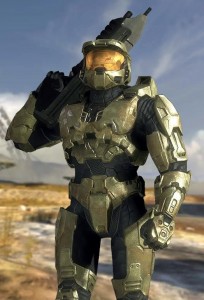
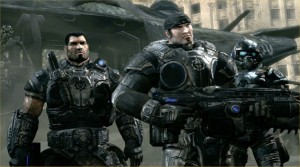


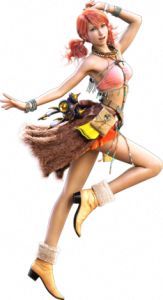
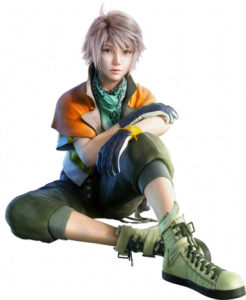

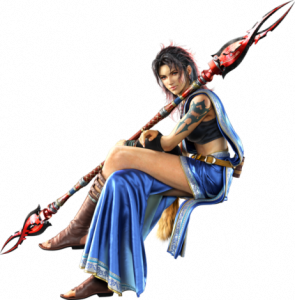
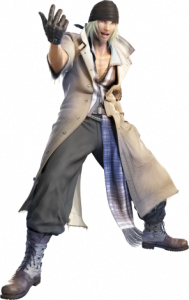
You know that there are buckets and barrels of slash fiction dealing with Final Fantasy, right?
I didn’t know there were buckets and barrels, but I’m not surprised in the least.
The Final Fantasy franchise has been slash-friendly for some time, but FFXIII takes it further than previous installments, I think. I probably should have mentioned that Fang and Vanille are not-so-subtly hinted at being more than just friends.
Thanks for the review – and the shoutout. I am, for the record, completely uninterested in playing games, but FFXIII has held some fascination for me, because of the Fang/Vanille relationship. I had a player review it at Okazu, focusing on the Yuri, with the gameplay taking a secondary role.
I hadn’t realized how generally gender-bendy it was, especialy the naming scheme.
Heaven knows that I am no gaming expert, but I thought your overview of the audience/environment pretty spot on. ^_^
I recently has a student write a “feminist” analysis of FF (not sure which number)…If only the student had written as clearly as you… Such are the vicissitudes.
The Okazu review of Final Fantasy is here.
And Erica’s discussion of the Bechdel test is here for those who missed it.
Eric- I hope you went easy on your student. God knows I wrote plenty of bullshit essays in college.
Final Fantasy mostly reflects pop culture trends in Japan, so it’s feminist only to the extent that Japanese pop culture is feminist. Which probably isn’t very much.
But it is clearly more female-friendly than most American game franchises, and that counts for something.
‘They appeal to the cosplay crowd rather than military enthusiasts. In other words, this game is kinda girly.”
One things that’s begun to confuse me as I think about Japanese culture is the “target audience” question. What’s going through the heads of developers making the game/ manga/ anime/ whatever.
For manga, I don’t think its sufficient to say “this ran in a shounen magazine” so its aimed at boys- its possible that only a Japanese industry insider could provide the whole story. I don’t know if anyone has data on gender breakdown of the actual shounen/ shoujo magazine readership?
Then there’s the issue of gender expectations.
A German tourist in Japan wrote in 2006:
“Feminine, well groomed excessively hairstyled and dressed to kill ( sometimes even including the handbag)” the current male beauty ideal strikingly resembles the current female beauty ideal”
http://tokyoblog.livejournal.com/2985.html
Is this accurate? Do we understand Japanese gender roles among young people?
While the top-selling console game last year was an FPS “shooter”, I wouldn’t say shooter games dominate. Here’s the Top 10 list for 2009:
1. 360 Call of Duty: Modern Warfare 2
2. wii wii Sports Resort w/ wii Motion Plus
3. wii New Super Mario Bros.
4. wii wii Fit w/ Balance Board
5. wii wii Fit Plus
6. wii Mario Kart w/ Wheel
7. wii wii Play w/ Remote
8. PS3 Call of Duty: Modern Warfare 2
9. 360 Halo 3: ODST
10. NDS Pokemon Platinum Version
You may notice something other than FPS games dominating the list.
Also, “And just like American superheroines, none of the women get to wear pants.” Other than Supergirl, name me a famous superheroine who wears a skirt. I can list off dozens in pants or shorts, but I’d struggle to name even 3 in skirts. The only iconic superheroine, Wonder Woman, is famous for wearing star spangled granny panties.
Do short-shorts or fishnets or short shorts count as pants? Starfire, Elektra, Black Canary — surely reasonable people can disagree as to whether they’re wearing pants….
WW started out in a skirt way back when, incidentally.
I think an equal to the slash appeal is the non-slash appeal of pretty leads, in what I suspect is completely unfemale friendly fantasy life…
I don’t actually think Japanese companies make a lot of games like Halo (the sort of apotheosis of the FPS genre), I guess the question is, are we comparing what the gamer public seems to like most or vs sells the most? I do think the overall gaming public in Japan seems more female friendly, but Dragon Quest is at the top of that heap, and Pokemon are probably up there, too. The latter being hugely popular in the US as well. And American consumers can of course rely on games like FF coming over to the US.
Actually, come to think of it, the strongest female lead in shooters is probably Samus from the Metroid series, and that’s a Japanese franchise. And also not nearly as popular in Japan.
Someone should one day try to parse out some thoughts on war and violence via video games in Japan–or America, too, but I’d love someone to talk me through what I see as a fascination with WWII via the Germans in Japanese games…
The Wii is an interesting counterpoint. Those games sell really well, and to a wide variety of consumers. On the other hand, of all those games on Gene’s list, only Super Mario Bros. could arguably be described as having a story. Wii Sports Resort and Wii Play have no characters or story at all. And Wii Fit isn’t really a game so much as an elaborate exercise device. They sell well, but without a narrative or characters I don’t believe they serve the same social function as Halo or FFXIII. Anyway, something for me to think about…
hcd- I don’t think Japanese companies produce games EXACTLY like Halo. First-person shooters are a mostly American phenomenon. But they produce plenty of by-the-numbers action games that demonstrate only a limited interest in character relationships. (And that’s not always a bad thing either, sometimes after a hard day you just want to go home and shoot zombies).
pallas said: “For manga, I don’t think its sufficient to say “this ran in a shounen magazine” so its aimed at boys- its possible that only a Japanese industry insider could provide the whole story. I don’t know if anyone has data on gender breakdown of the actual shounen/ shoujo magazine readership?”
If you can read Japanese, or are willing to wrestle with online translators, the Japanese Magazine Publisher’s Association has demographic breakdowns for some of the larger manga magazines: shonen and seinen here, shoujo and a few borderline-josei here. From their data, the shonen magazines reported on have 75-95% male readership (mostly towards the 90%-ish end), the seinen mags run a little bit more mixed, while shoujo has a 98-100% female readership.
“In shooters, story, character, and environment are typically just window-dressing for the action. Speaking from purely anecdotal experience, I’ve noticed that RPGs, and the Final Fantasy franchise in particular, seem to be very popular among female gamers. I’d wager that the reason for this is the the greater attention paid to relationships and character interaction. (And before someone accuses me of unfairly maligning all American games, there are plenty of American RPGs that offer gameplay similar to Final Fantasy XIII, though I would point out that many of them still embrace the techno-militaristic aesthetic of the popular shooters).”
Final Fantasy XIII would appear to be an attempt to graft middling CG anime to a very restrictive gaming environment (one of the most restrictive found in FF games). Metal Gear Solid 4 (which is techno-militaristic to the nth degree) plays better in that respect and is a far better game. That women should be attracted (even superficially speaking) to such banal and juvenile material is no greater cause for joy than the idea of men being attracted to shooting aliens. It merely reflects the choice of product available to women in the gaming world.
Video games tend to be written, produced and directed by men. My feeling is that the female characters in FFXIII are just the Japanese versions of Lara Croft with a better back story (this reflects the different game genres they were created for). I’m not convinced that Japanese game producers are any less chauvinistic or misogynistic or whatever than Western game producers. However, I appreciate that Japanese RPG designers create pretty nifty outfits for their female characters (Lulu in FFX for example). Japanese RPG gamers and game producers just tend to be attracted to different sorts of women (in the case of Vanille, a kind of infantilized femininity). This isn’t altogether bad since it’s one step up from what used to be the usual depiction of women in video games (that is, virtually non-existent or peripheral, rare exceptions not noted here). Lara Croft used to empowering for a brief (very brief) moment of time despite her short shorts and before the porn elements overtook her. Most people tend to forget what a great platform game the first Tomb Raider was when it first appeared and to have a female character at the center of that was something like the creation of Wonder Woman for comics (well, not quite). Shows you how backward the world of Western video games is when it comes to plot and characeterization.
I would say that Western RPGs like Dragon Age do a slightly (very slightly) better job at the whole relationship thing in that you’re not force fed recycled saccharine nonsense which we’ve come to expect from Japanese RPGs (I should add that the better and more classic Japanese titles transcend this but FFXIII isn’t one of them as Richard will agree I’m sure). The lesbian sex in those Western RPGs is way too much like the male porn versions of the same so it’s a bit like comparing an apple with 3 worms in it rather than 4 but beggars can’t be choosers.
…and Suat kills all the joy. Everyone is shocked!
My sense from my no doubt inadequate readings is that the Japanese are more comfortable with gender bending in their narratives, probably because of traditions like these. I don’t think that translates necessarily into less misogyny — though it seems like it can in certain situations (it certainly has in Japanese comics, for example.)
Has anybody seen the Final Fantasy movies? I tried watching one I think and it was completely incomprehensible…so much so that I don’t remember anything about it, I don’t think….
Yes, but you might also say that the same tradition (reinforced by modern media)leads to a greater comfort with borderline cradle snatching (at least intellectually speaking).
Which FF movie are you talking about? The “realistic” one called The Spirits Within which nearly killed Square (previous owner of the FF franchise) or FFVII: Advent Children which is a sequel to the FFVII game?
Both of them are probably worse storywise than games like FFVII and FFX which is saying a lot. The latter movie would probably be confusing if you didn’t play the game. I don’t remember much about them either but that’s mainly because they were so average that I instantly forgot them. Go play the games. They will *only* cost you <50 hours of your life.
Sidenote: I only recently discovered that Jason Lutes (creator of Berlin) was an avid board and video game player.
I think it’s Advent’s Children. And I am not, not, not, starting playing video games. I don’t have enough time as it is!
I’d say you’re right about the underage stuff, absolutely. If you wanted to be glib (and why not?) you could say that it’s all about not having a Puritan past…..
I agree with Suat that FFXIII isn’t the best RPG that Square Enix ever produced (that would either be the original Chrono Trigger or Final Fantasy VI). And it never really amounts to anything more than middling entertainment, but it’s middling entertainment that’s appealing to a much broader audience than most Western games.
As for Dragon Age and it’s sister title from Bioware, Mass Effect, I enjoy both of those games quite a bit. In terms of gameplay, I prefer the much greater number of choices and ability to effect the outcome of the story that those games (and Western RPGs, in general) provide. And it’s worth noting that those games allow the player to select the gender of the main character.
But as Suat’s point about lesbian sex demonstrates, these games are still very much boy’s adventures, even though there’s a token acknowledgment that girl’s might like to play too.
Oh, and the Final Fantasy movie you’re talking about is Final Fantasy VII: Advent Children, which makes no sense EVEN IF you’ve played the game.
Suat’s mostly right about the writing … I guess bad writing just doesn’t bother me as much in games than in movies or books. Different media, different expectations.
JRBrown wrote:
“From their data, the shonen magazines reported on have 75-95% male readership (mostly towards the 90%-ish end), ”
Thanks, JR.
What throws me off is, take a title like Azumanga Daioh…
http://en.wikipedia.org/wiki/Azumanga_Daioh
It ran in a Shounen magazine. Does a manga like this not appeal to women?
Was it designed to appeal to women?
if you haven’t read it, basically about 5 high school age girls, doing random things. It sort of reminds me of Seinfeld in a “show about nothing” sort of way. Its been a while since I’ve look at it, but if the girls are sexualized, I don’t think they are are all *that* sexualized.
Would it have been sold as “something that will appeal to boys age 10+” or “something that can bring some women into the readership”?.
And if it doesn’t appeal to women, why not? There’s no romance in the series, no relationship stuff, is that why? Do most girls dislike reading manga that lacks these elements? Does that immediately make it boys stuff?
Or does it not appeal to girls because it happens to run in a boys magazine ? Would girls pick it up in trade?
I know it varies some from series to series Pallas. The creator of the shounen samurai series Rurouni Kenshin is always complaining/joking in his author’s notes that all his fanmail is from girls….
pallas:
Dengeki Daioh (home of Azumanga Daioh) isn’t really shounen; it’s seinen aimed at younger guys (late teens to mid-twenties), and, more importantly, geeky younger guys. They run a lot of borderline sort-of-loli stuff, and a lot of moe cute-girls-doing-nothing-in-particular stuff. Azumanga Daioh is one of the latter; the nothing-happening is sort of the point, in that it’s all about the “gentle world of girls”, who don’t have the social expectations and demands that men do and can just hang out being cute (note that this is more of a male fantasy than actual Japanese reality). They are supposed to be kind-of sexually appealing, but in an innocent, cute moe way, not in a slutty vixen way. Azumanga Daioh does have female readers, but it’s not a series that’s aimed at attracting them (unlike, say, Monthly GFantasy, home of Black Butler, which is very interested in pulling in a female crossover audience, and very successful at it too).
It’s entirely possible to change the target audience for manga when it moves overseas; Dengeki Daioh is also home of Yotsuba&!, which is more of the cute-world-of-girls stuff, and also the cute-underage-girl-living-with-older-guy stuff, but is being positioned in the US as an all-ages story suitable for kids. (This is probably only possible because it’s separated from the other more-questionable stuff that runs in the magazine.) I don’t know who’s buying Azumanga Daioh in the US, but it could well be women.
Speaking of seinen titles, a lot of people don’t realize that EMMA was actually running in a seinen magazine. I assume the draw was the maid-fetish appeal, even though it went in an entirely different direction than what otaku usually associate with maids.
As for Japanese FPS, actually the Japanese equivalent would probably be “third person” shooters in the Resident Evil vein.
Actually, Comic Beam (home of Emma) is an “alternative” mag that does a substantial amount of cross-market and / or highbrow stuff, so the appeal may well have been “sensitive historical romance”. It also ran Wandering Son, coming soon from Fantagraphics, which is definitely another not-just-for-guys title. Much seinen is indeed of the action-and-babes variety, but manga for gender-undifferentiated adult readers is also usually published as seinen. It’s the most diverse manga category, aside from the stuff that is simply uncategorizable.
“The creator of the shounen samurai series Rurouni Kenshin is always complaining/joking in his author’s notes that all his fanmail is from girls….”
When I was a teenager, I used to watch bootleg copies of the Rurouni Kenshin anime, with a really lousy fan-sub. It was one of those shows that’s very formulaic, but it doesn’t come across as generic because it executes the formula so well. Plus, while it had plenty of action, it also had several romantic sub-plots (and pretty men). Easy to see why both girls and boys liked it.
JrBrown wrote:
“Dengeki Daioh (home of Azumanga Daioh) isn’t really shounen; it’s seinen aimed at younger guys (late teens to mid-twenties), ,”
Ah, it seems wikipedia mislead me :) Thanks, that makes a lot more sense. I thought it was weird that Wikipedia was classifying Azumanga Diaoh, A Certain Scientific Railgun, and Shakugan no Shana mangas as “10 and older”. 10 seemed a bit young for those titles. I assumed it was some cultural thing.
I’m guessing there’s no western equivalent to “gentle world of girls” so that aspect was kind of lost on me.
Pallas: “I thought it was weird that Wikipedia was classifying Azumanga Diaoh, A Certain Scientific Railgun, and Shakugan no Shana mangas as “10 and older”. 10 seemed a bit young for those titles.”
Well, the shounen category covers magazines aimed at boys, broadly 8-18, so “10 and older” is technically accurate for the category, but most shounen mags aren’t aimed at all of this range; a specific mag might be designed for preteens (for example, Korokoro, whose average reader is 10), or for younger teens (V Jump, 13ish), or for older teens (Shonen Champion, 16ish). Shoujo, likewise, is split by age; Ribbon (preteen) isn’t going after the same market segment as Margaret (late teens through early 20s). Weekly Shonen Jump, the most popular shounen mag (and the most popular manga mag, period) has an unusually broad readership, which really does span 8 to 18 (and beyond), but that’s not really typical.
This is a great review. Though there are still many sexist thigns in “Final Fantasy XIII”:
He had the cliché, over-used story of: Boy thinks his dad is a bastard, and only has his mother. His mother tragically dies and he blames someone, hates them and plots to kill them.
He had no reason to complain about his father. To me, Bartholomew is a loving, supportive caring man, despite what had happened to his son. I mean, he burst into tears when he learned Nora was dead!
For once I would like a story like this where it is a teenage GIRL (it is always a teenage boy with these kinds of stories!) has a strained relationship with her MOTHER (it is “father-issues”) and the FATHER who tragically dies.
What makes me hate him even more, along with his personality, is the fact that he receives Alexander, the coolest Summon! He is made ‘special’ as his Eidolon was other only one who was the same gender as its l’Cie and his was the only weapon not visible outside of battle! He also got all Ravager spells (expect the ‘-strike’ ones), and the highest magic stat which again, is unfair, as he does not deserve it when Vanille had being a l’Cie for far longer!
The ‘groups’ are sexist, as all of them have a BOY as the youngest and smallest chartacter. Main Cast had Hope, NORA had Maqui, and Sazh had Dajh.
Speaking of Dajh, we already had Dajh lose his mother, so why did Square do another story where another boy lost his mother?!